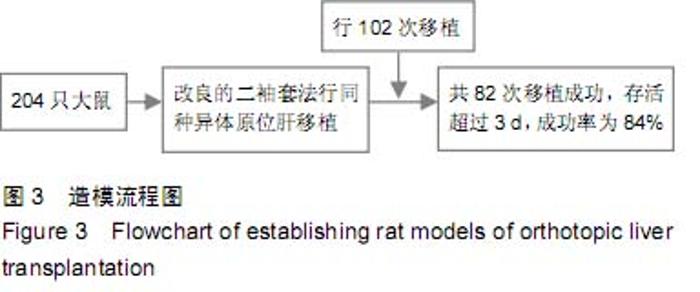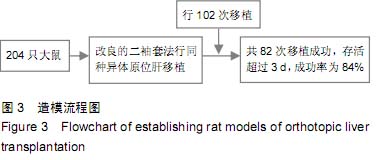| [1] 康永振,沈中阳.肝移植移植后胆道并发症的相关病因分析[J].实用器官移植电子杂志,2013,(1)4:243.
[2] Kashfi A, Mehrabi A, Pahlavan PS, et al. A review of various techniques of orthotopic liver transplantation in the rats. Transplant Proc. 2005;37(1):185-188.
[3] 王轩,杨甲梅,严以群,等.大鼠原位肝移植不同术式的探讨[J].中华器官移植杂志,1998,19(2):76-78.
[4] Lee S, Charters AC, Chandler JG, et al. A technique for orthotopic liver transplantation in the rat. Transplantation. 1973;16(6):664-669.
[5] 傅宇阳,何晓顺,陈剑琳,等.肝组织ICA M-1和LFA-1表达对急性排斥反应的诊断价值[J].中国普通外科杂志,2002,11(1):37-40.
[6] Yamaguchi Y, Halperin EC, Harland RC, et al. Significant prolongation of hamster liver transplant survival in Lewis rats by total-lymphoid irradiation, cyclosporine,and splenectomy.Transplantation. 1990;49(1):13-17.
[7] 沈中阳.正视发展中的中国肝脏移植[J].中国危重病急救医学, 2010,22(1):2-3.
[8] Wakiya T, Sanada Y, Mizuta K, et al. Interventional radiology for hepatic artery complications soon after living donor liver transplantation in a neonate. Pediatr Transplant. 2012;16(3): E81-E85.
[9] 李志伟,李超,马继韬,等.血型不相容肝移植新型策略临床的应用[J].中国普通外科杂志,2011,20(1):6-10.
[10] 巫北海,周代全,蔡萍等.活体形态学腹盆上卷[M].北京:科学出版社,2006,4:193.
[11] de Ville de Goyet J, Hausleithner V, Malaise J, et al. Liver procurement without in situ portal perfusion. A safe procedure for more flexible multiple organ harvesting. Transplantation. 1994;57(9):1328-1332.
[12] Cherqui D, Hingot JL, Humeres R, et al. Harvesting of the liver without in situ cannulation of the portal system. J Am Coll Surg. 1994;178(6):622-623.
[13] Schemmer P, Enomoto N, Bradford BU, et al. Activated Kupffer cells cause a hypernetabolic state after gentle in situ manipulation of liver in rats. Am J physiol Gastrointest Liver Physiol. 2001;280(6):G1076-G1082.
[14] Schemmer P, Schoonhoven R, Swenberg JA, et al. Gentle in situ liver manipulation during organ harvest decrease survival after rat liver transplantation. Transplantation. 1998;65(8): 1015-1020.
[15] 王爽,高毅,孙尔维,等.双袖套法大鼠原位肝移植术的改进[J].广东医学,2001,22(9):783-785.
[16] 陈绪贵,王卓强,石炳毅,等.肝脏移植手术期间机体组织氧代谢和乳酸的变化[J].解放军医学杂志,2003,28(8):710-711.
[17] Guo Y, Feng L, Zhou Y, et al. Systematic review with meta-analysis: HIF-1α attenuates liver ischemia-reperfusion injury. Transplant Rev (Orlando). 2015;29(3):127-134.
[18] Zhuonan Z, Sen G, Zhipeng J, et al. Hypoxia preconditioning induced HIF-1α promotes glucose metabolism and protects mitochondria in liver I/R injury. Clin Res Hepatol Gastroenterol. 2015.
[19] Ferrigno A, Di Pasqua LG, Bianchi A, et al. Metabolic shift in liver: correlation between perfusion temperature and hypoxia inducible factor-1α. World J Gastroenterol. 2015;21(4): 1108-1116.
[20] Teoh NC, Ajamieh H, Wong HJ, et al. Microparticles mediate hepatic ischemia-reperfusion injury and are the targets of Diannexin (ASP8597). PLoS One. 2014;9(9):e104376.
[21] Jiang W, Kong L, Ni Q, et al. miR-146a ameliorates liver ischemia/reperfusion injury by suppressing IRAK1 and TRAF6. PLoS One. 2014;9(7):e101530.
[22] Zhang C, Huang C, Tian Y, et al. Polyol pathway exacerbated ischemia/reperfusion-induced injury in steatotic liver. Oxid Med Cell Longev. 2014;2014:963629.
[23] Wang Y, Li C, Cheng K, et al. Activation of liver X receptor improves viability of adipose-derived mesenchymal stem cells to attenuate myocardial ischemia injury through TLR4/NF-κB and Keap-1/Nrf-2 signaling pathways. Antioxid Redox Signal. 2014;21(18):2543-2557.
[24] Akhtar MZ, Sutherland AI, Huang H, et al. The role of hypoxia-inducible factors in organ donation and transplantation: the current perspective and future opportunities. Am J Transplant. 2014;14(7):1481-1487.
[25] Nativ NI, Yarmush G, So A, et al. Elevated sensitivity of macrosteatotic hepatocytes to hypoxia/reoxygenation stress is reversed by a novel defatting protocol. Liver Transpl. 2014; 20(8):1000-1011.
[26] Orci LA, Lacotte S, Oldani G, et al. The role of hepatic ischemia-reperfusion injury and liver parenchymal quality on cancer recurrence. Dig Dis Sci. 2014;59(9):2058-2068.
[27] Huang H, Hou M, Xu J, et al. Roles of heme oxygenase-1 promoting regeneration of peribiliary vascular plexus in bile duct ischemia/reperfusion injury. Zhonghua Wai Ke Za Zhi. 2014;52(3):193-197.
[28] Tao T, Chen F, Bo L, et al. Ginsenoside Rg1 protects mouse liver against ischemia-reperfusion injury through anti-inflammatory and anti-apoptosis properties. J Surg Res. 2014;191(1):231-238.
[29] Oldani G, Crowe LA, Orci LA, et al. Pre-retrieval reperfusion decreases cancer recurrence after rat ischemic liver graft transplantation. J Hepatol. 2014;61(2):278-285.
[30] Yan H, Jihong Y, Feng Z, et al. Sirtuin 1-mediated inhibition of p66shc expression alleviates liver ischemia/reperfusion injury. Crit Care Med. 2014;42(5):e373-e381.
[31] Morrissey PE, Monaco AP. Donation after circulatory death: current practices, ongoing challenges, and potential improvements. Transplantation. 2014;97(3):258-264.
[32] Cheng L, Tian F, Tian F, et al. Repression of Farnesoid X receptor contributes to biliary injuries of liver grafts through disturbing cholangiocyte bile acid transport. Am J Transplant. 2013;13(12):3094-3102.
[33] Zimmerman MA, Kam I, Eltzschig H, et al. Biological implications of extracellular adenosine in hepatic ischemia and reperfusion injury. Am J Transplant. 2013;13(10): 2524-2529.
[34] Ke B, Shen XD, Zhang Y, et al. KEAP1-NRF2 complex in ischemia-induced hepatocellular damage of mouse liver transplants. J Hepatol. 2013;59(6):1200-1207.
[35] Zimmerman MA, Grenz A, Tak E, et al. Signaling through hepatocellular A2B adenosine receptors dampens ischemia and reperfusion injury of the liver. Proc Natl Acad Sci U S A. 2013;110(29):12012-12017.
[36] Zimmerman MA, Tak E, Ehrentraut SF, et al. Equilibrative nucleoside transporter (ENT)-1-dependent elevation of extracellular adenosine protects the liver during ischemia and reperfusion. Hepatology. 2013;58(5):1766-1778.
[37] 周立红,朱跃辉.大量输血后血清电解质及酸碱平衡的变化[J].临床急诊杂志,2008,9(2):80-81. |

